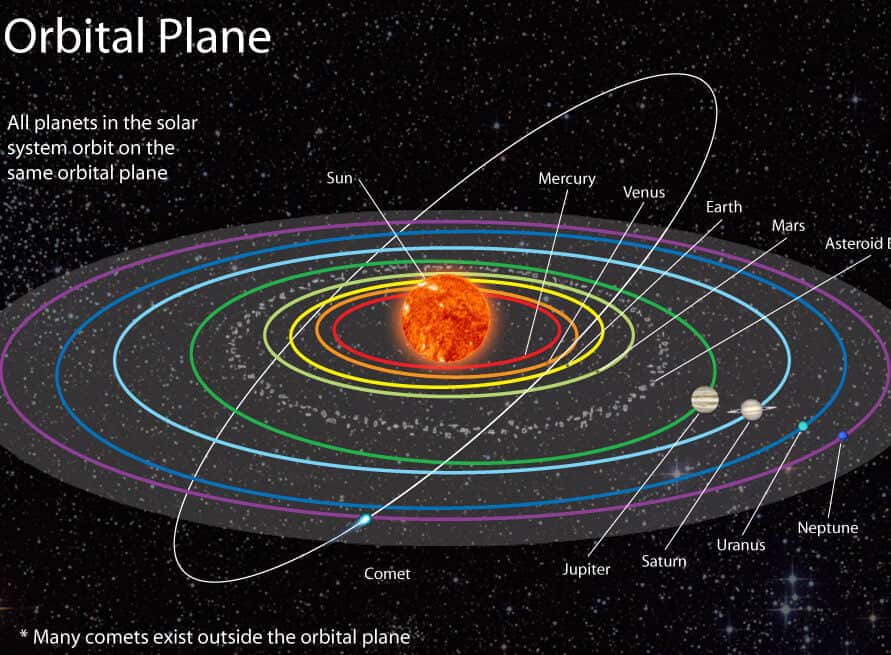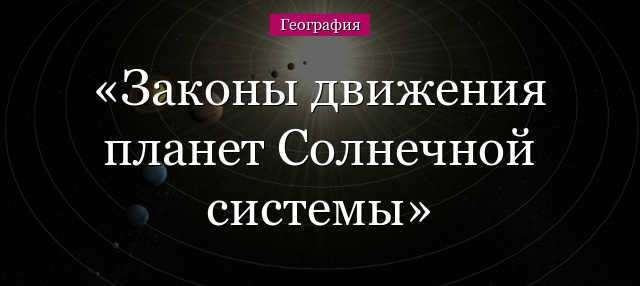
Johannes Kepler, a German scientist, was the one who discovered the laws of motion of the planets in the solar system. While studying Nicolaus Copernicus’ system and observing celestial bodies by Tycho Brahe, he was the first to uncover the fundamental laws governing the movement of celestial bodies around the Sun. These laws later became known as Kepler’s three laws, marking a significant breakthrough in seventeenth-century astronomy.
Kepler’s First Law
Johannes Kepler, a mathematician and astronomer from Germany, dedicated his studies to the exploration of the solar system during the 17th century. While analyzing the scientific findings of Copernicus and Brahe, he identified discrepancies in the descriptions of planetary orbits and discovered that some planets did not follow a perfect circular path. By refining the existing knowledge, Kepler was able to formulate the laws that govern the motion of planets within our solar system.
Through extensive observations, Kepler determined that the orbits of all planets in our system lie almost within the same plane. The majority of celestial bodies follow an elliptical path, which closely resembles a circle. However, there are two exceptions – Mars and Pluto – which have more elongated orbits around the Sun.
Kepler’s first law states that the planets in the solar system travel in a closed path shaped like an ellipse, with the Sun located at one of the foci.
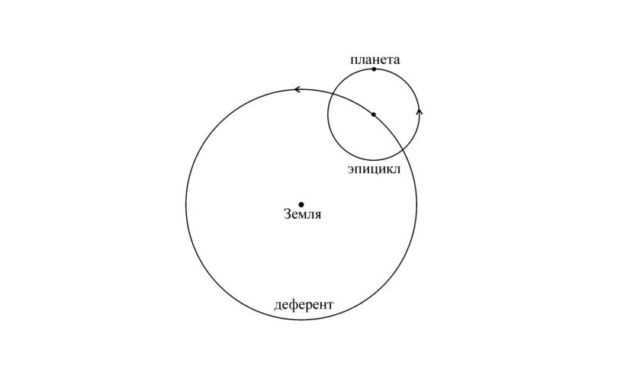
There are only two foci. These two points lie within the curve, and the sum of the distances from any point on the ellipse to these foci remains constant.
The type of orbit that a celestial body follows is determined by its velocity. When a body reaches a certain velocity, it will follow a circular path around the center of attraction. This velocity, known as the first escape velocity, is given to artificial satellites launched into orbit around Earth. It is approximately 8 kilometers per second.
After determining that the shape of the planets’ orbits is an ellipse, the scientist made the decision to investigate the specific sections of the orbital path where the celestial bodies experience deceleration and acceleration.
According to Kepler’s second law, every planet moves in a plane that passes through the center of the Sun. Additionally, for equal time intervals, the radius-vector connecting the Sun and the planet will trace out equal areas.
Within the solar system, there are two key principles related to Kepler’s second law:
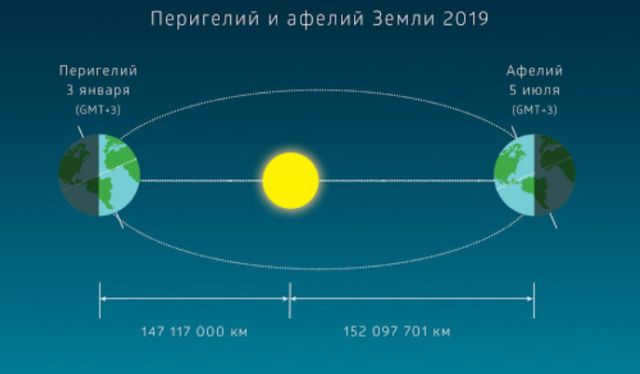
- The point in the orbit closest to the Sun is known as perihelion;
- The furthest point in the orbit is referred to as aphelion.
In order to maintain the constancy of areas, a celestial body must move at varying speeds at different points in its orbit. For example, the Earth moves around the Sun at a faster linear velocity at perihelion compared to aphelion.
The Law of Kepler
There is a direct correlation between perihelion and aphelion, which are connected by the major axis of the orbit. This segment can be divided in half to obtain the major semi-axis, which is commonly used in astronomy.
Kepler’s third law states that the ratio of the number of complete revolutions around the central star for any two planets in the system squared is always equal to the ratio of the major semi-axes of the orbital paths of these bodies squared to the cube.
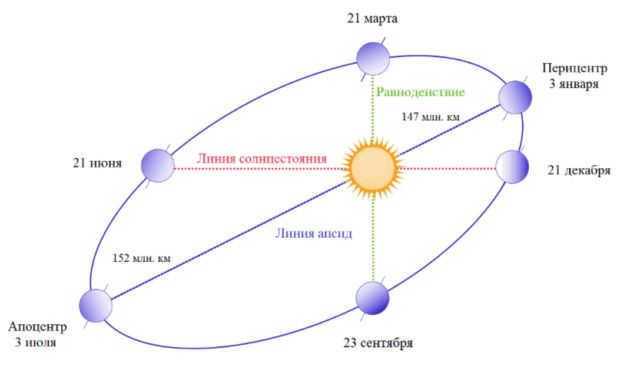
By utilizing this principle, it becomes feasible to compute the duration of a planet’s year by knowing its distance from the Sun. Furthermore, one can determine the orbit by using this principle and knowing the period of revolution.
Kepler’s third law applies to both planets and satellites, and its margin of error does not exceed 1%.
When composing a geography report for a fifth-grade class on planetary motion within the solar system, it is crucial to provide an explanation of Kepler’s three fundamental laws.
What did we learn?
Kepler’s laws describe the patterns of motion of celestial bodies around the Sun. The planets of the solar system are aligned in a single plane and orbit the star in an elliptical trajectory. Consequently, the planets travel at varying velocities at different points in their orbit. Additionally, Kepler’s laws enable us to calculate the orbit or duration of a year for any given planet.
1. Complete the sentences in the passage: “To compile a comprehensive understanding of the universe was attributed to ________________. In a renowned publication known as the Almagest, the primary focus is on outlining the ___________________ of a celestial system in which the Earth, a spherical body, occupies a central and stationary position… It was ____________________ a theory that facilitated the ability to forecast the precise location of all the planets.”
"regardless of its size, he positioned it at the center of the system, and all the other planets, including Jupiter, revolved around it in circular orbits."
3. What discoveries made by G. Galileo and M. V. Lomonosov through telescopes confirmed the validity of the heliocentric model of the universe?
1. What is the orbital period of Jupiter if its synodic period is 399 days?
2. How frequently do oppositions of Mars, which occur every 2.1 Earth years, repeat?
3. Calculate the sidereal orbital period of Mars, given that its synodic period is 780 Earth days.
4. Within what time frame do the moments of maximum distance between Venus and Earth repeat, if Venus has a stellar period of 225 Earth days?
5. What is the orbital period of Venus around the Sun if its conjunctions with the Sun occur every 1.6 Earth years?
6. What is the orbital period of the outer planet around the Sun if its oppositions occur every 1.5 Earth years?
Theoretical Station
1. Identify the inner planets from the following:
2. Identify the outer planets from the following:
3. In what type of orbits do the planets revolve around the Sun? Choose the correct answer:
4. How do the orbital periods of planets change with the distance from the Sun?
A. The farther a planet is from the Sun, the longer its orbital period.
B. The orbital period of a planet is not affected by its distance from the Sun.
B. The period of orbit decreases as the distance between a planet and the Sun increases.
5. Identify the planets that could potentially be in an upper conjunction.
6. Determine which planets can be observed in opposition.


Advanced Training Course
Analysis of the Signs in a Fictional Work during the Literature Lesson within the Framework of the Realization of the Federal State Educational Standard
We can offer you an additional discount for your educational institution, which will depend on the number of your colleagues who have already completed Infowork courses.
Currently, there are additional cumulative discounts available (ranging from 2% to 25%) for 58,740 educational institutions. To find out the specific discount applicable to all employees of your educational institution, please log in to your personal Infoworks account.


Enhance your professional skills with our development course.
Experience the program “1C: CRM”.
We are pleased to offer you an additional discount for your educational institution, which will be based on the number of colleagues who have already taken Infowork courses.
Currently, we provide additional discounts (ranging from 2% to 25%) for 58,740 educational institutions. To determine the applicable discount for all employees of your institution, please log in to your personal Infoworks account.


Professional development course
Professional Ethics in Psychological and Pedagogical Activity
We have the ability to apply your educational institution’s discount to this offer (it will depend on the number of your colleagues who have completed Infoworks courses).
At present, 58,740 educational institutions are benefiting from additional discounts (ranging from 2% to 25%). To discover the discount that is available for all staff members at your educational institution, please access your personal Infoworks account.


Preparation for the USE in literature. Uniqueness of D. I. Fonvizin’s comedy “Nedorosl”
Document selected for viewing: Development of ideas about the structure of the world.docx
Development of ideas about the structure of the world. Configurations of planets. Synodic period.
Teacher: Andrey Nikolaevich Baryshnikov
Type of lesson: Lesson for learning and consolidating new knowledge.
Personal: Expressing conviction in the possibility of understanding the world system.
Metacognitive: The aim is to understand the cause-and-effect relationships behind the changing ideas about the structure of the world. It also involves recognizing the contribution of scientists to the formation of the astronomical picture of the world. Students should be able to present information about the mutual location of the planets in various formats (text, figures, tables) and draw conclusions about the observability of the planets based on the external conditions of the Sun and Earth’s location.
Subjective: The objective is to convey historical information about the formation and development of the heliocentric system of the world. Students should be able to explain the looping motion of the planets using epicycles and differentials. They should also be able to define terms and concepts such as “configuration of planets” and “synodic and sideric periods of planetary circulation.”
Solving both theoretical and practical problems and collaborating within a group to discuss them, emphasizing the significance of a problem with supporting evidence, succinctly and accurately presenting ideas, responding to inquiries, and providing additional information.
Students’ activities
Organizational moment. (1 minute)
Greeting the students. Establishing a positive mindset for the lesson.
Greeting the teacher. Preparing for the lesson.
Motivating the learning activity and introducing the lesson’s purpose and objectives.
The teacher introduces the topic of the lesson, states the lesson’s objectives, and explains the lesson’s structure.
The students listen and take necessary notes.
Reviewing the lesson (3 minutes)
The teacher presents the task on the screen and monitors the students’ progress.
The students answer the questions displayed on the slides.
Watching a 10-minute video clip provides an opportunity for students to view and practice discipline. During this activity, they watch the video and take notes to enhance their learning experience.
After watching the video, students engage in a text-based activity for 10 minutes. This task involves creating an outline based on the material they have learned.
During the next phase of the lesson, students listen to the teacher’s instructions and take notes. This helps them consolidate their understanding of the topic.
The teacher then conducts a frontal questioning session for 5 minutes. They explain the task on the screen and supervise the students’ work. Students are required to answer questions based on the slides.
Following the frontal questioning, students have a 12-minute independent work period. The teacher organizes and monitors their progress. Students answer questions on their itinerary sheets.
Once the independent work period is over, the teacher facilitates a discussion to analyze and evaluate the students’ work. They also continue to organize and monitor the students’ progress during this phase.
At the end of the lesson, the teacher evaluates the students’ work based on the proposed criteria. They summarize the lesson and distribute the lesson report, which takes approximately 1 minute.
Summarizing the lesson and explaining the homework.
In order to solve these tasks, the class is divided into groups of two. The students are assigned the task of taking each group to a specific station according to the requirements outlined in the itinerary.
1. Complete the sentences in the text: “It is the responsibility of astronomers to create a comprehensive understanding of the universe. In the book “Almagest”, the main focus is on presenting the geocentric system of the world, where the Earth is positioned at the center… It was a groundbreaking theory that allowed for the advanced prediction of the planets’ locations.”
2. Fill in the missing words in the text: “In his cosmological model, Copernicus relegated Earth”
assuming the role of an average planet, which he positioned at the center of the system, and all the other planets, along with it.
while they moved around the Sun in circular orbits.”
3. What did the telescopic discoveries by G. Galileo and M. V. Lomonosov confirm about the truth of the heliocentric system of the world?
1. What is the orbital period of Jupiter in relation to the stars if its synodic period is 399 days?
2. How often do the oppositions of Mars occur, considering its synodic period is 2.1 Earth years?
3. Calculate the orbital period of Mars in relation to the stars, given that its synodic period is 780 Earth days.
4. Within what time frame do the moments of maximum distance of Venus from the Earth repeat, if its orbital period is equal to 225 Earth days?
5. If the upper conjunctions of Venus with the Sun repeat every 1.6 years on Earth, what is the orbital period of Venus around the Sun?
6. If the oppositions of the outer planet repeat every 1.5 years on Earth, what is its orbital period around the Sun?
Station “Theoretical”
1. Determine which of the following planets are classified as inner planets:
2. Identify the outer planets from the following options:
3. What type of orbits do the planets have around the Sun? Select the correct answer:
4. How do the periods of planetary orbits change as a planet moves farther away from the Sun?
A. The farther a planet is from the Sun, the longer its orbital period is.
B. The orbital period of a planet is not affected by its distance from the Sun.
B. The further a planet is from the Sun, the shorter its revolution period.
5. Determine which planets may be in an upper conjunction:
6. Determine which planets can be observed in opposition:
1. the Sun’s rotation around its axis
2. Aristotle’s cosmological model.
3. ancient philosophers’ concepts of the world’s structure.
4. Observation of the planets crossing the Sun’s disk and their scientific importance.
5. Explanation of the planets’ looping motion based on their arrangement.
Document chosen for viewing: Development of the concept of the world’s structure.pptx
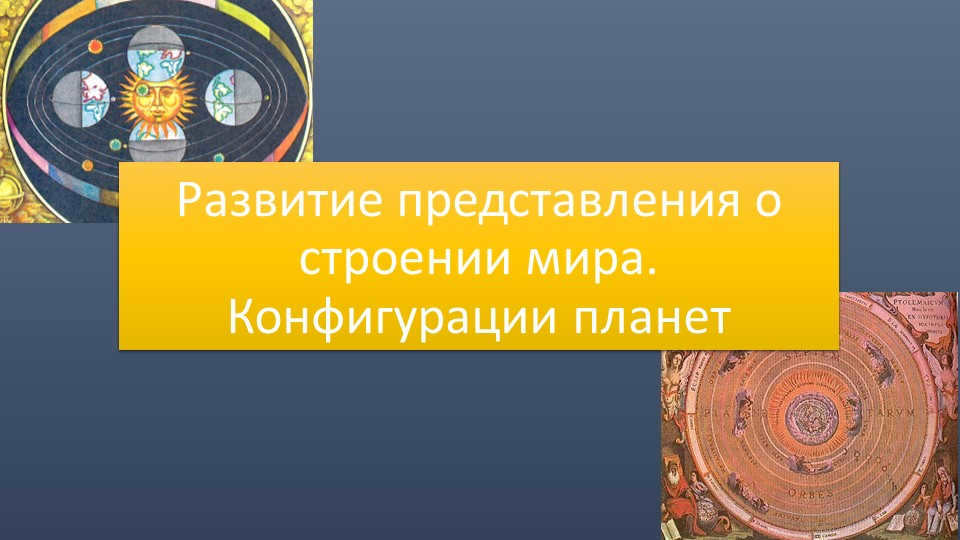
Breakdown of the presentation’s content by individual slides:

Lesson Objectives for Slide 2
Recreate the historical information surrounding the creation and advancement of the heliocentric model of the universe. Explain the planetary motion using epicycles and differentials.
Recall the definitions of the terms “configuration of planets” and “synodic and sideric periods of planetary orbits.”
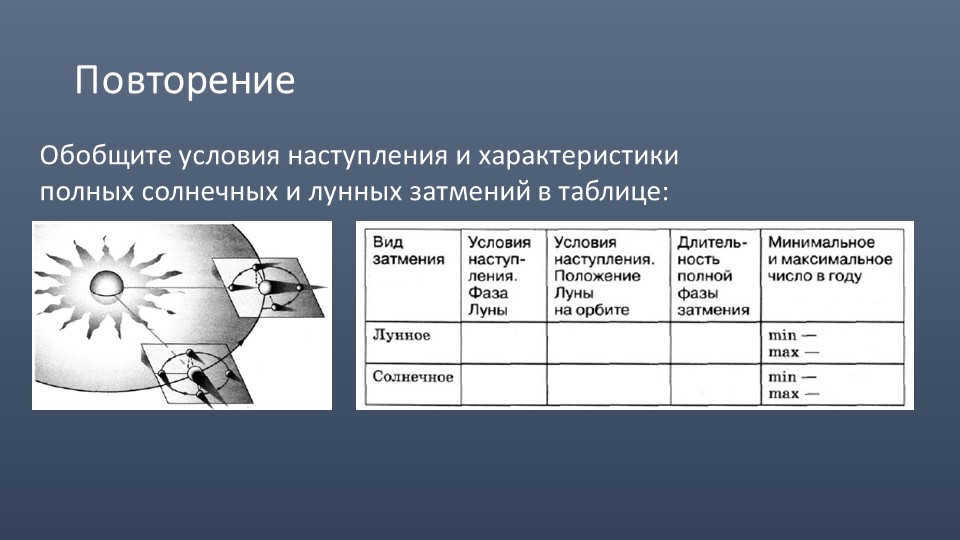
Slide 3 Repetition
Provide a concise overview of the circumstances and features
of complete solar and lunar eclipses in the provided table:
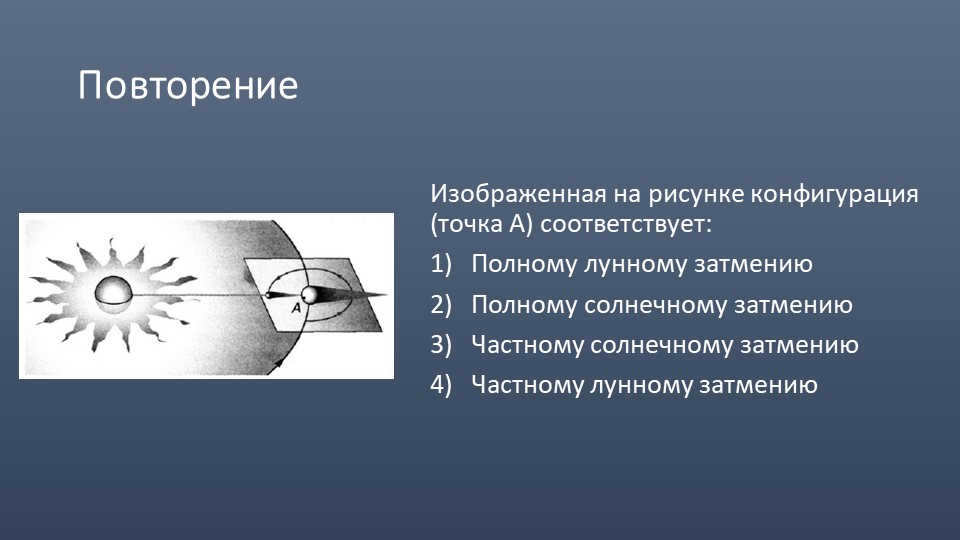
Rephrasing the text, while keeping the HTML markup:
4 slide Repetition
The arrangement shown in the diagram (at point A) corresponds to:
A complete lunar eclipse
A complete solar eclipse
A partial solar eclipse
A partial lunar eclipse

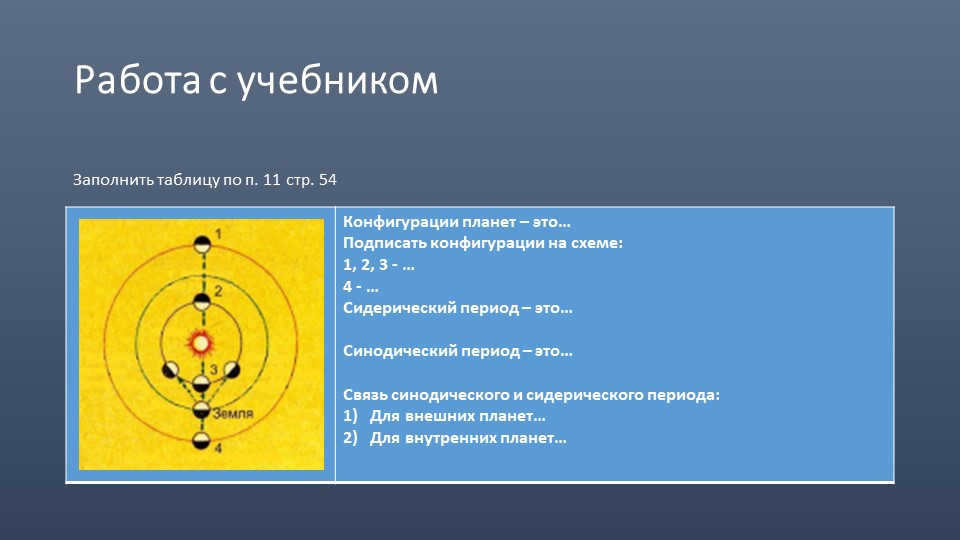

Slide 8: Exploring the Concepts
Let’s delve into the ideas of Pythagoras and Democritus regarding the structure of the world. What were their distinct viewpoints?
Now, let’s move on to understand the world system proposed by Ptolemy. How does it differ from the world system proposed by N. Copernicus?
Next, we’ll examine the groundbreaking telescopic observations made by Galileo Galilei. What were some of his most significant findings?
Now, let’s explore the configurations of the planets. How do they vary?
Additionally, we’ll discuss the concepts of quadrature and elongation. Can you explain what they mean?
Furthermore, we’ll examine the synodic period of a planet. What does it signify?
Finally, we’ll explore the sideric period of a planet. What is its significance?
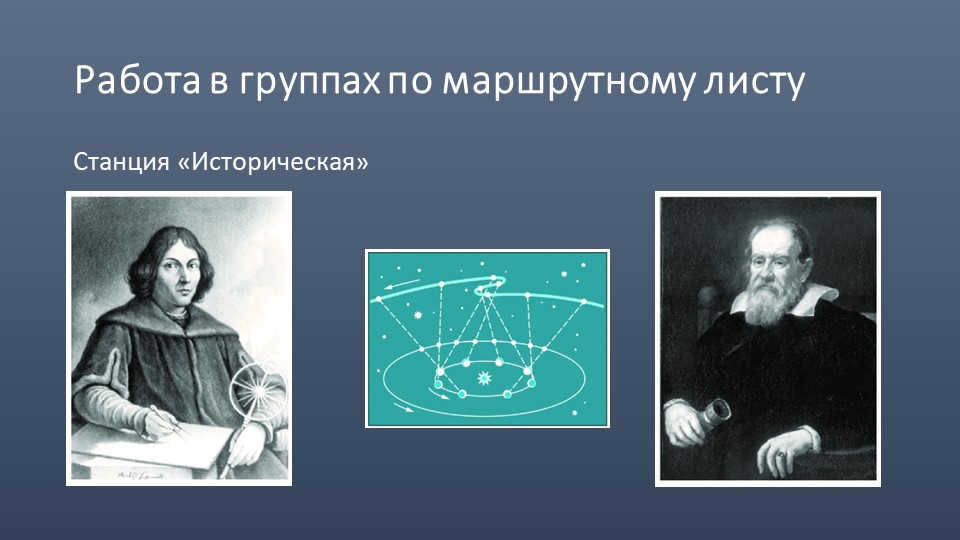
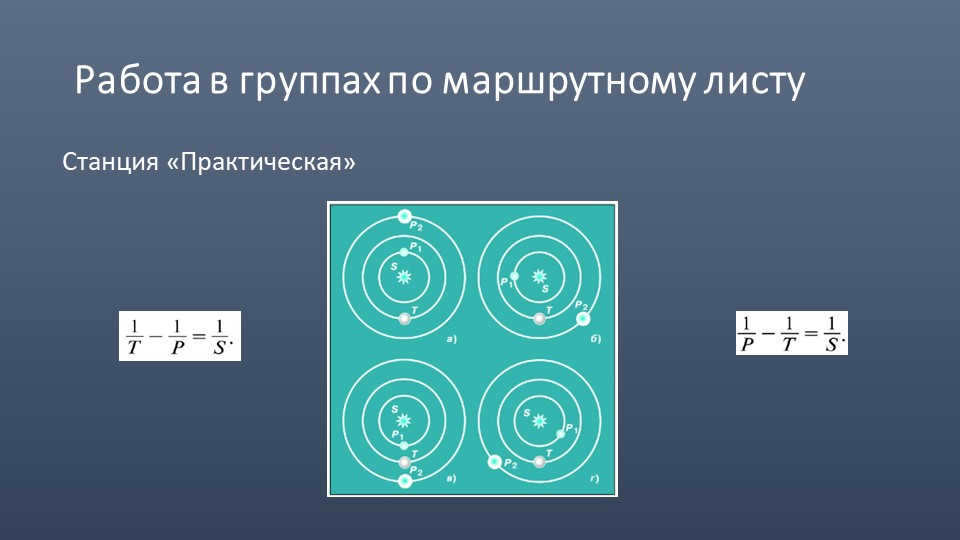
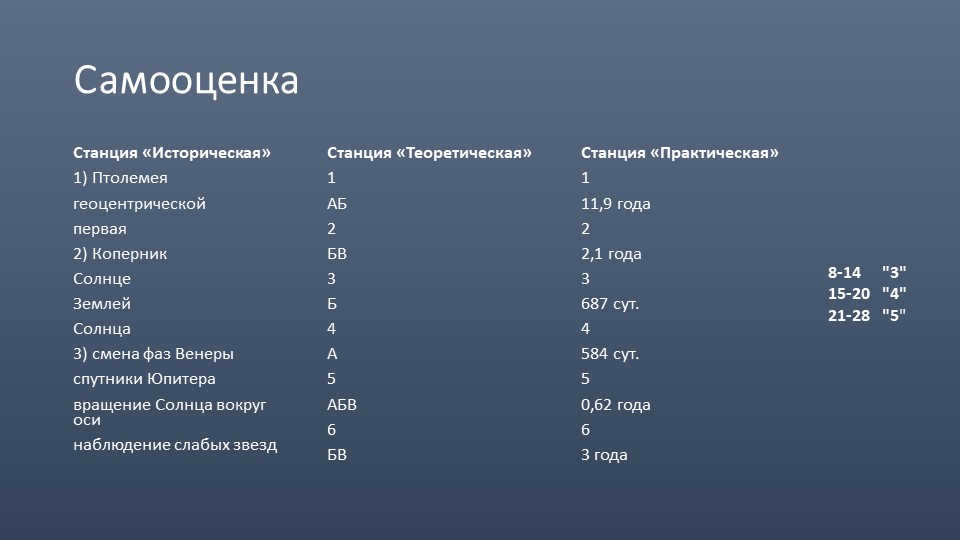
Slide 12 Self-Evaluation
Historical Station
1) Ptolemy’s
geocentric
initial
2) Copernicus
Sun
around the Earth
around the Sun
3) Variation in Venus’ appearance
Jupiter’s moons
rotation of the Sun
observation of dim stars
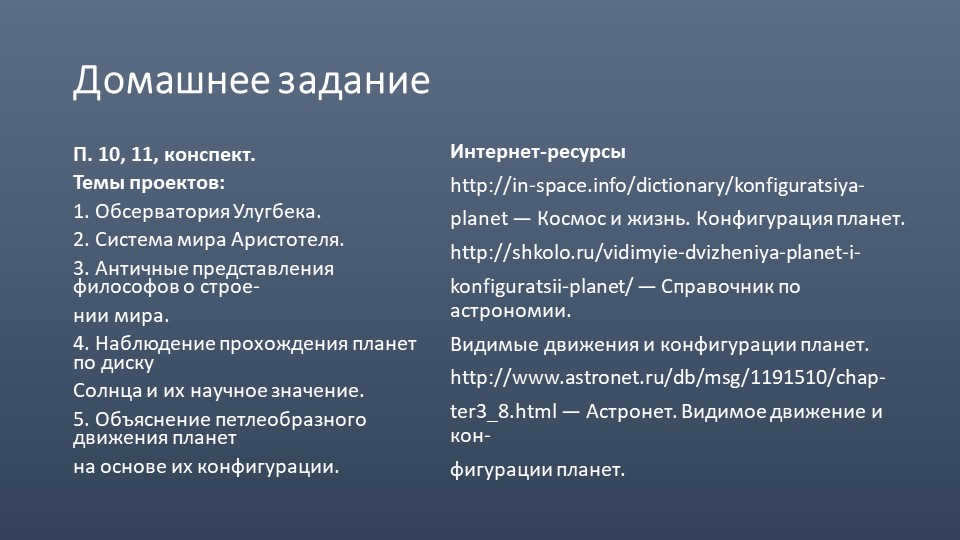

13 slide Homework
Section 10, 11, outline.
Options for the project:
1. Ulugbek’s Observatory.
2. Aristotle’s model of the universe.
3. Ancient philosophers’ concepts of the world’s structure.
4. The study of planets passing across the Sun’s disk and their scientific importance.
5. Elucidation of the planets’ looping motion based on their arrangement.

Brief summary of the document:
Exploring the concept of the universe’s structure. Planetary configurations and the synodic period.
Instructor: Andrey Baryshnikov
Lesson Type: A lesson focused on acquiring and reinforcing new knowledge.
Individual: Expressing belief in the capacity to comprehend the world’s system.
Meta-characteristic: The meta-characteristic focuses on establishing cause-and-effect relationships regarding the changing ideas about the structure of the world. It also aims to characterize the contribution of scientists towards shaping the astronomical picture of the world. Additionally, it presents information about the mutual location of the planets in various forms such as text, figures, and tables. Furthermore, it draws conclusions about the observability conditions of the planets based on the external conditions of the Sun and Earth’s locations.
Subjective: The subjective aspect aims to reproduce historical information about the formation and development of the heliocentric system of the world. It also explains the looping motion of the planets using epicycles and differentials. Furthermore, it reproduces definitions of the terms and concepts “configuration of planets” and “synodic and sideric periods of planetary circulation.”
Educational materials – the textbook “Astronomy, 11th grade” by B.A. Vorontsova-Viliaminova and E.K. Strout; supplementary materials include a video clip titled “Nicolaus Copernicus and the concept of heliocentrism”.
Types of activities:
The activities involve solving both theoretical and practical problems, collaborating in group discussions, identifying and presenting relevant problems, presenting ideas concisely and accurately, answering questions, and making additions.
To solve these problems, the class is divided into groups of two. Each group is assigned to a specific station according to the requirements specified in the itinerary.
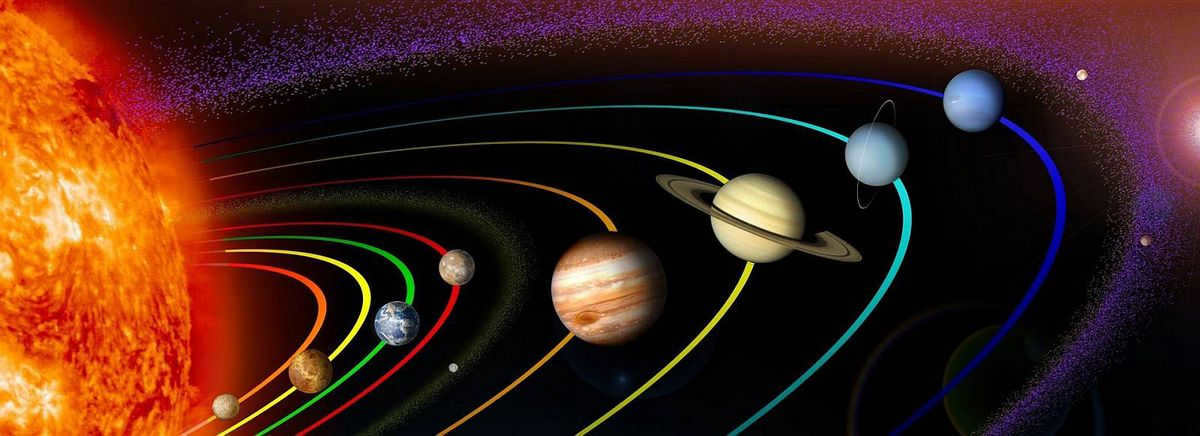
In the ancient times, scientists came to understand that it is not the Earth that orbits around the Sun, but rather the opposite is true. Nicolaus Copernicus introduced this controversial concept to humanity. The Polish astronomer developed his heliocentric model, in which he convincingly demonstrated that the Earth is not the center of the universe, and all the planets, according to his strong belief, revolve around the Sun in orbits. The Polish scientist’s publication “On the Rotation of the Celestial Spheres” was released in the German city of Nuremberg in 1543.
Prior to Copernicus.
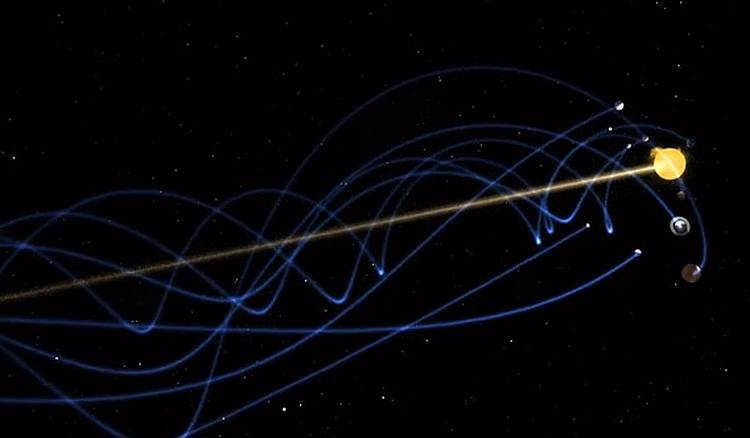
The path of motion in space
In his treatise “The Great Mathematical Construction of Astronomy”, the ancient Greek astronomer Ptolemy proposed the initial concept of the arrangement of planets in the sky. He was the first to suggest that their movements follow a circular trajectory. However, Ptolemy incorrectly believed that all planets, including the Moon and Sun, revolve around the Earth. Prior to Copernicus’ groundbreaking work, Ptolemy’s treatise was widely accepted in both the Arab and Western civilizations.
From Brahe to Kepler: A Journey through Time

After the death of Copernicus, the work was continued by Tycho Brahe, a Danish astronomer. Brahe, who was incredibly wealthy, furnished his island with impressive bronze circles where he recorded the findings from his celestial observations. These findings proved to be instrumental in the research conducted by Johannes Kepler, a mathematician. It was Kepler, a German scientist, who organized and categorized the motion of the planets within the solar system and formulated his three renowned laws.
Kepler was the first to demonstrate that the 6 planets known at that time revolve around the Sun in elliptical orbits, rather than in circles. The English scientist Isaac Newton made a significant contribution to our understanding of elliptical orbits with his discovery of the law of universal gravitation. His explanation of how the Moon’s gravitational influence affects Earth’s tides was widely accepted in the scientific community.
Around the Sun
Circling the star at the center of our solar system is a celestial body known as Earth. This blue-green planet is home to a diverse array of life forms, including humans. As it orbits the sun, Earth experiences seasons, with varying temperatures and lengths of daylight. The tilt of its axis causes the changing angles of sunlight, resulting in different climates and landscapes across the globe. From the frozen tundras of the Arctic to the lush rainforests of the equator, Earth’s diverse ecosystems are a testament to the power of our planet’s journey around the sun.
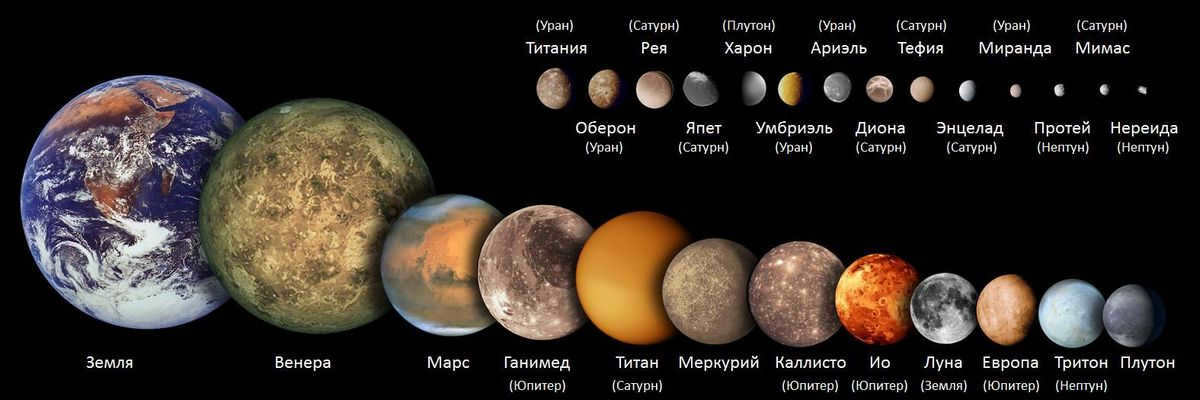
The comparative sizes of the largest satellites of the solar system and the Earth-group planets can be observed in the image above.
Each planet has a unique period of revolution around the Sun. Mercury, being the closest planet to the star, completes its revolution in just 88 Earth days. On the other hand, our Earth takes 365 days and 6 hours to complete its cycle. The largest planet in the solar system, Jupiter, has a revolution period of 11.9 Earth years. In contrast, Pluto, the most distant planet from the Sun, has an incredibly long revolution period of 247.7 years.
It is important to consider that all the planets in our solar system are in motion, not around the sun, but around the center of mass. Each planet also rotates on its axis and has a slight wobble, similar to a yule. Furthermore, the axis of a planet may experience slight shifts.
Enjoyed this article? Share it with your friends!
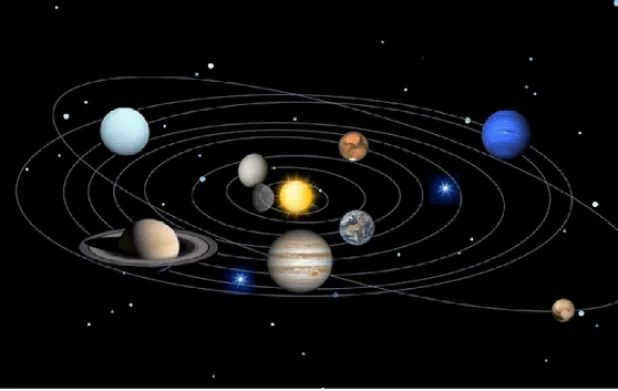
It is widely known today that all the planets of the solar system orbit around the Sun. However, it took humanity many centuries to discover this fact. For a considerable period of time, individuals held the belief that the Earth was the center of the universe and that the Sun revolved around it.

In today’s dynamic world, simply relying on the traditional school curriculum is no longer sufficient. It is crucial to gain valuable insights into finance and investments in order to secure one’s financial well-being.
Take charge of your future by expanding your knowledge and skills in financial literacy today. Access the online course on FINANCIAL LITERACY.

Join now, APPLY FOR YOUR SUCCESS
Various forms of planetary movement
Ptolemy initially proposed the concept of the arrangement of the celestial bodies in his work “The Great Mathematical Construction on Astronomy”. According to Ptolemy, the planets, including the Sun and the Moon, revolve around the Earth in circular orbits. This theory was widely accepted in both Western and Arab civilizations until Copernicus presented his findings.

Source
Copernicus revolutionized the understanding of the universe by introducing the heliocentric system. In his revolutionary work “On the Rotation of the Celestial Spheres,” published in 1543, he challenged the prevailing belief that the Earth was the center of the universe. Instead, he proposed that the planets orbit the Sun in circular paths. This groundbreaking theory laid the foundation for modern astronomy and forever changed our perception of the cosmos.
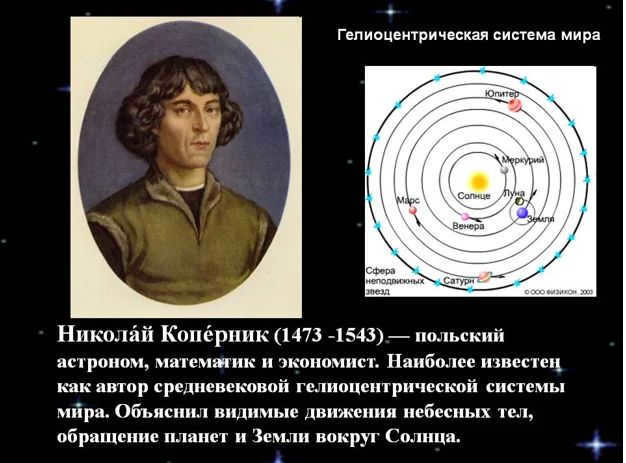
Source
Tycho Brahe, an astronomer and follower of Copernicus, conducted observations of celestial bodies on his own island using huge bronze circles. His findings were later passed on to mathematician Johannes Kepler, who formulated the three laws of planetary motion.
The first law of planetary motion. Kepler initially worked with the assumption that planets move in circular orbits, but his calculations did not align with actual observations. As a result, he hypothesized that the orbits are actually elliptical in shape. Each elliptical orbit has two focal points, which are known as foci. Therefore, Kepler’s first law states:
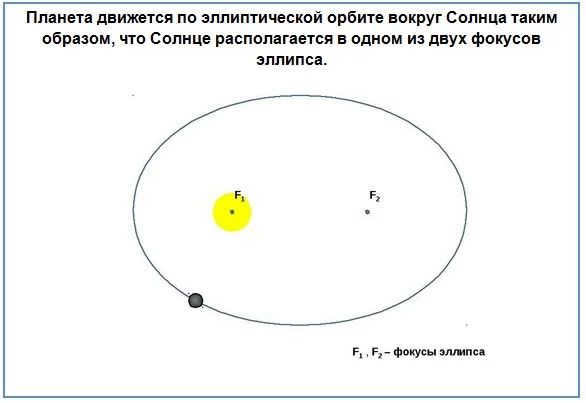
The second principle of planetary motion. In order to comprehend this principle, one must trace a line from the Sun to the planet. The celestial body should be positioned at one of the focal points of the orbit. Over an equal period of time, this line will cover the same amount of area on the plane where the planet orbits around the Sun.
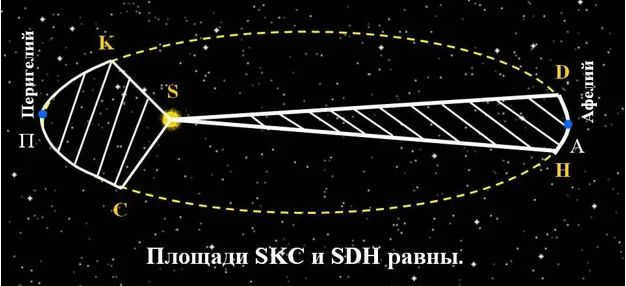
The law of planetary motion states that every planet’s orbit has a point that is closest to the Sun (perihelion) and a point that is farthest from the Sun (aphelion). The major axis of the orbit is the line segment connecting these two points. In astronomy, the major semi-major axis, which is obtained by dividing the major axis in half, is commonly used.
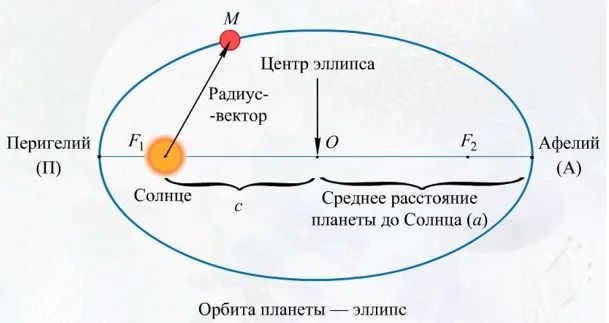
Original
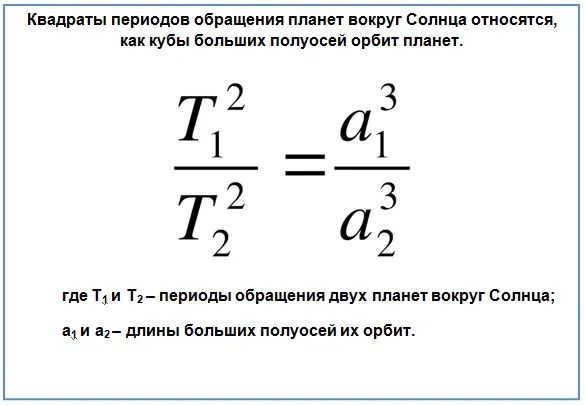

This principle is utilized for determining the duration of a year, which is the time it takes for a planet to complete one revolution around the Sun (T). To calculate this, you only need to know the distance between the Sun and the planet (a).
In contemporary astronomy, there exist various forms of planetary motion:
Prior to delving into a more detailed exploration of each type of planetary motion within the Solar System, it is essential to acknowledge that all planets are typically classified as either upper or lower, or inner and outer. The lower (inner) category encompasses Mercury and Venus, while the upper (outer) category includes all others (Mars, Jupiter, Saturn, Uranus, Neptune). This classification is based on the Earth’s orbit.
When the lower planets, like Mercury and Venus, move in their orbit, they go through a phase change just like the Moon. There are two significant points during their motion: the lower conjunction and the upper conjunction. The lower conjunction is when the inner planet is closest to the Earth, while the upper conjunction is when it is farthest away. At the lower conjunction, the inner planet is located between the Earth and the Sun, making it invisible to observers on Earth. As the planet moves away from this position, it starts to appear as a crescent shape. The larger the angle between the planet and the Sun, the larger the crescent shape becomes. When the angle reaches 90 degrees, observers can see exactly half of the illuminated side of the planet. However, at the upper conjunction, the fully illuminated side of the planet is facing away from Earth and is not visible due to the Sun’s rays. This phenomenon is unique to the lower planets, as the upper planets always appear illuminated from the perspective of Earth. If an observer were to go beyond Saturn’s orbit, they would be able to see the phase changes on Earth, Mars, Jupiter, and Saturn. However, binoculars are not enough to see these phases from Earth, as a telescope would be required.
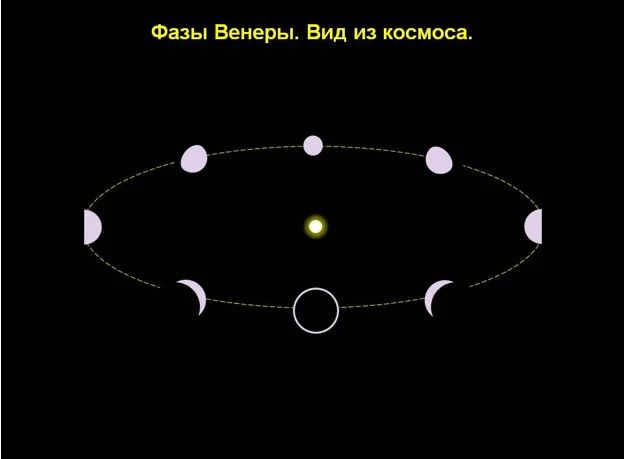
Backward, forward and looping motion of the planets
The motion of the planets in a forward direction is known as direct motion, which refers to their movement from west to east, following the path of the Sun.
On the other hand, the backward motion of the planets, also known as retrograde motion, refers to their movement in relation to the stars in the sky from east to west. In simple terms, it is the opposite direction to the motion of the Sun and Moon.
When studying the visible movement of the solar planets, it is always important to consider the motion of the planet being observed as well as the Earth itself in its orbits around the Sun. According to Newton’s law of universal gravitation, the orbital velocity of a planet decreases as it gets farther away from the Sun. This means that when two planets “confront” each other, the one closer to the Sun begins to “catch up” with the one further away due to its higher speed of motion. Additionally, during periods of retrograde motion, observers notice that planets move in loops as a result of the tilt of their orbits relative to the plane of the ecliptic. In other words, the sideways movement of outer planets is not a result of them moving in the opposite direction, but rather because the Earth, being closer to the Sun and moving at a faster speed in its orbit, overtakes them at certain times.
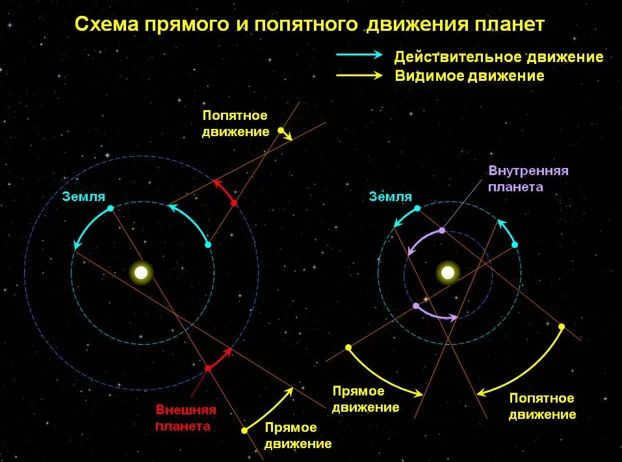
Source
The Sun’s Path: The Ecliptic and its Motion
Ancient astronomers have long observed that the Sun’s position at noon varies throughout the year. Furthermore, depending on the season, if one looks towards the southern horizon at midnight, different constellations become visible. For instance, constellations seen in the summer months are completely absent during winter. Conversely, winter stars in constellations cannot be seen during the summer. These observations led to the discovery of the Sun’s annual motion relative to the stars, which is now known as the ecliptic.

We are already aware that the movement of the Sun is a relative concept. The apparent movement of the star occurs in relation to the Earth’s orbit around the Sun. The Earth completes a full rotation around its axis, which takes 23 hours 56 minutes and 4 seconds, resulting in the Sun shifting by 1 degree per day in the sky. The time it takes for the Sun to complete a full circle on the celestial sphere is known as a year, which consists of 365 days and 6 hours. Every fourth year is considered a leap year, as extra days accumulate during this time. Therefore, leap years have one additional day, totaling 366 days.
Zodiacal constellations
As the Earth moves along its orbit, it completes one full circle in a year. During this time, the Sun passes through 13 constellations known as zodiacal constellations, as it moves along the ecliptic line.
To put it simply, the constellations that align with the ecliptic are referred to as zodiacal constellations.
In modern astronomy, there are actually 13 zodiacal constellations, instead of the traditional 12. Each of these constellations was given a name by ancient astronomers, and these names have been used for many years. Typically, the names were chosen based on their resemblance to certain objects, animals, or images. Today, these constellations are widely recognized and known by their respective names. The 13 zodiacal constellations are:
- Aries.
- Taurus.
- Gemini.
- Cancer.
- Leo.
- Virgo.
- Libra.
- Scorpio.
- Serpentine.
- Sagittarius.
- Capricorn.
- Aquarius.
- Pisces.
If you begin the Sun’s movement report from Aries (April 19-May 3), then exactly one year later the star will be in the same constellation once again. The Moon will pass through all the zodiacal constellations in a shorter time period, just a month. This is because it only takes 27 days for the Moon to complete a full revolution around the Earth. The constellations and planets will move at different speeds, depending on their distance from the Earth and the Sun. The starting point for the zodiacal constellations was determined to be the vernal equinox point – March 20.
The International Astronomical Union officially established the modern boundaries of constellations in 1928.
Ancient Greece recognized Aries as one of its ancient constellations, which is located in the Northern Hemisphere and can be seen clearly throughout Russia. The best time to observe Aries is during the summer, fall, and winter. According to legend, Aries represents a magical ram with twisted horns, known as the golden fleece. The Argonauts embarked on a journey to obtain this golden fleece, sailing on the ship called “Argo.”
Aries consists of 57 stars that are visible to the naked eye. In terms of size, it ranks 39th among the 88 modern constellations. Some of its bright stars include Hamal, Sheratan, Mezartim, and Botein.
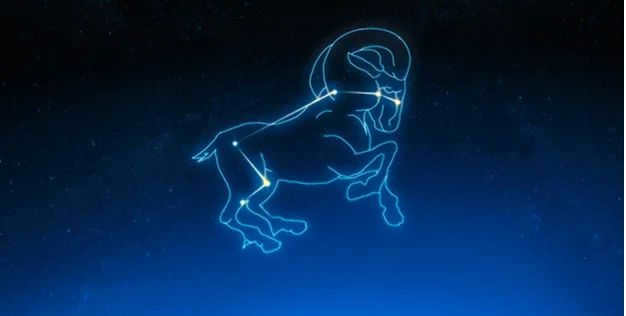
The constellation is part of ancient traditions and beliefs. It held sacred and revered status in many cultures. Taurus can be easily seen from various locations around the world. Even without the aid of any instruments, one can observe the 216 stars that form the Taurus constellation. It is located in the Northern Hemisphere and is best observed during the months of November to January. Notable bright stars in Taurus include Aldebaran, Nat, and Alcyone. It ranks as the 17th largest constellation in the night sky.
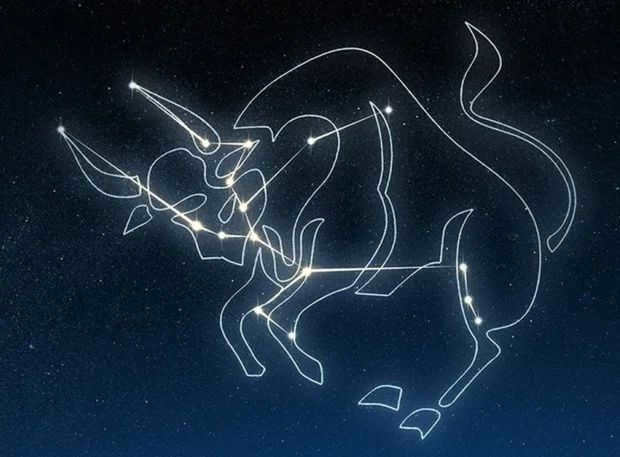
Situated in the Northern Hemisphere, the Gemini constellation consists of two relatively bright stars, Castor and Pollux, which are located in close proximity to each other. These stars symbolize the heads of twin brothers, and their feet align with the Milky Way, pointing towards the southwest. Gemini is most visible during the months of December and January. It offers a stunning view of 70 stars that can be observed with the naked eye, making it the 30th largest constellation in terms of area.
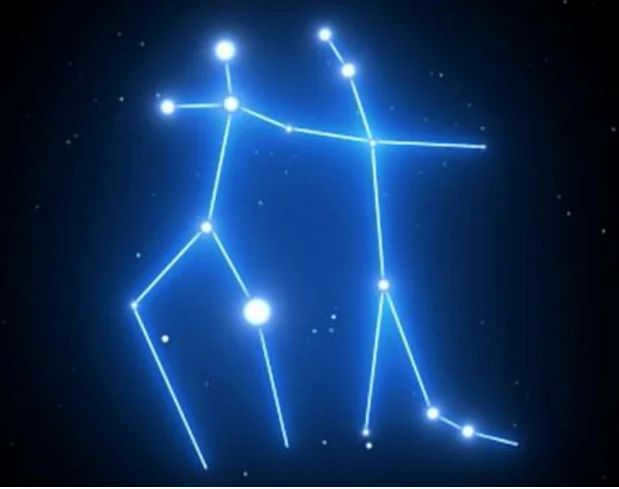
The constellation situated in the Northern Hemisphere holds the 31st position in terms of its area. It is one of the oldest and ordinary constellations. The best period for observing this zodiacal constellation is between January and February. The background of this constellation has a fascinating story. During his battle with the Lernaeus Hydra, Heracles was attacked by the sea Cancer. The courageous warrior managed to defeat the enemy. However, the goddess Hera, who had a grudge against Heracles, decided to immortalize Cancer by placing it in the sky. Without the use of any instruments, the 60 stars of Cancer can be seen only on a clear night without any disturbances. Altarf and Akubens are the prominent stars of this constellation.
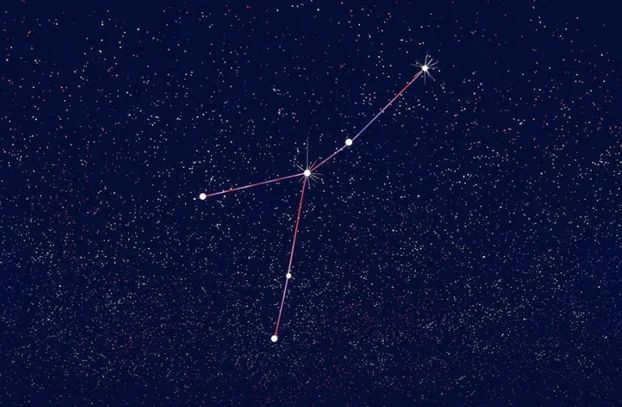
Ranked 12th in terms of area, this constellation in the Northern Hemisphere is easily visible to the naked eye, with a total of 70 stars. The optimal months for observing this constellation are February through March. The body of the Lion is depicted by a trapezoid formed by four bright stars, while the head is a curved line of stars. The brightest star in this constellation is Regulus, which shines with a white-blue hue.
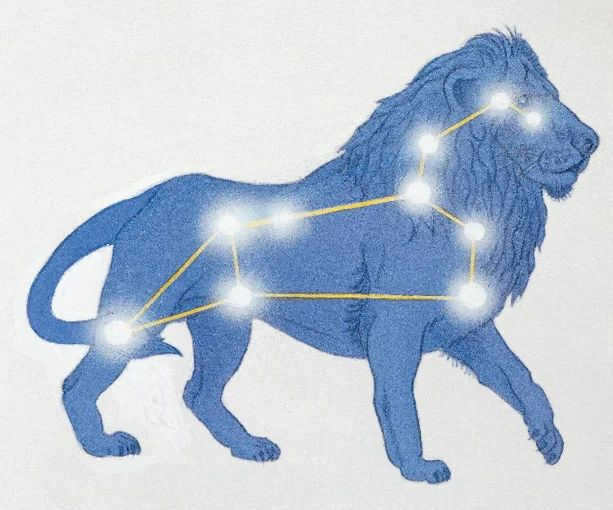
Virgo holds the top position in terms of brightness among the zodiacal constellations and comes in second among the total of 88 constellations officially recognized. It is situated in the Southern Hemisphere. The shape of the constellation resembles that of a pentagon. The autumnal equinox point is located within Virgo. The best time to observe the constellation is during March and April. A total of 95 stars in Virgo can be seen with the naked eye, without the need for any instruments. Notable stars in the constellation include Porrima, Spica, and the quasar #3C 273, which is one of the brightest.
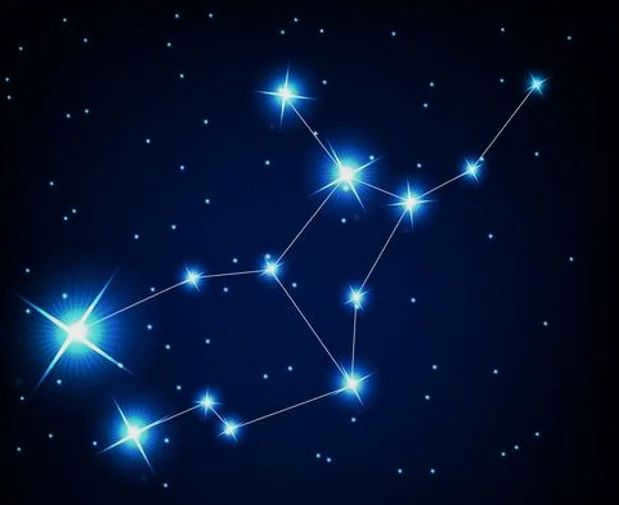
Libra is situated in the Southern Hemisphere and is the 29th largest constellation in terms of area. It is highly recognizable in the night sky and can be seen without the aid of any instruments. There are a total of 83 stars that can be observed within this constellation. The best time to observe Libra is during the months of April and May. The constellation is most visible in the central and southern regions of Russia. The story behind the creation of Libra is quite fascinating. It is said that the daughter of Zeus and the goddess Themis Astraea brought this object with her when she visited Earth. Astraea, who was blindfolded, held the scales in her hands to fairly assess human life and identify those who were dishonest, deceitful, and broke the law. Zeus decided to immortalize this object in honor of his daughter.
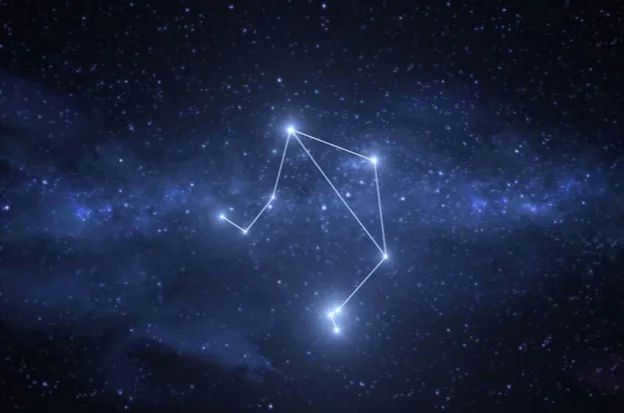
Situated in the Southern Hemisphere along the Milky Way, Scorpius showcases a unique arrangement of stars. The most captivating feature of this zodiacal constellation is the red supergiant known as Antares. This star boasts a diameter and luminosity that surpasses the Sun by hundreds of times. Additionally, Scorpius is home to multiple star systems, with 100 stars visible to the naked eye. Late summer offers the best opportunity to observe this constellation. In terms of size, Scorpius ranks as the 33rd largest star in the sky.
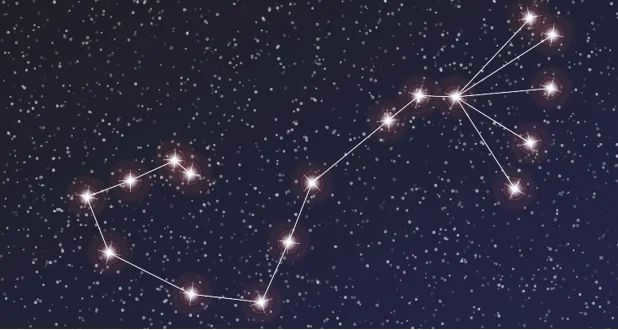
Situated in the Southern Hemisphere, it is the 11th largest constellation in terms of area. It is distinguished by a vast collection of stars, with around 100 of them visible to the naked eye. This zodiacal constellation has been known by its current name since ancient times. The depiction of the Serpent represents Asclepius, the gifted healer. Notable stars in this constellation include Ras Alhage and Sabic.
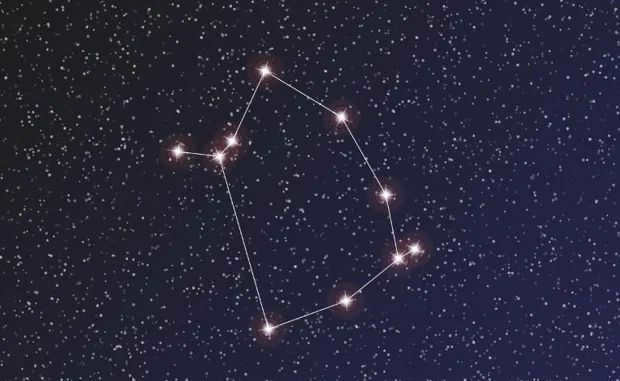
Located in the Southern Hemisphere, Sagittarius is ranked 15th in terms of area. With a total of 115 stars visible to the naked eye, this constellation is known for its main stars, including Kaus Australis, Nunki, and Zeta Ascella. Sagittarius is particularly visible in southern Rossi, making July-August the ideal months for observation.
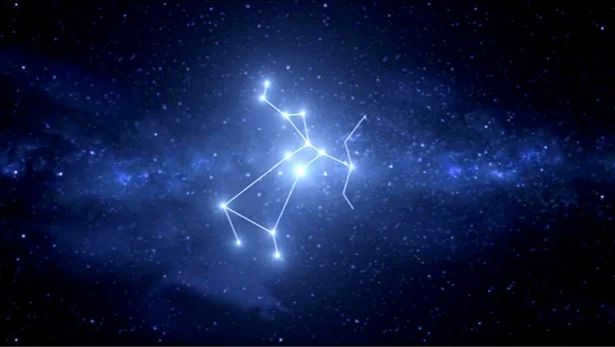

This constellation can be found in the Southern Hemisphere and is the 40th largest in terms of area. Around 50 stars in the constellation are visible without the need for optical devices. It can be easily seen in the southern and central parts of Russia. The best time to observe Capricorn is during the months of July and August. Capricorn is a fascinating creature that has the body of a goat with a tail of a fish. One notable feature of Capricorn is the presence of the globular cluster M30.
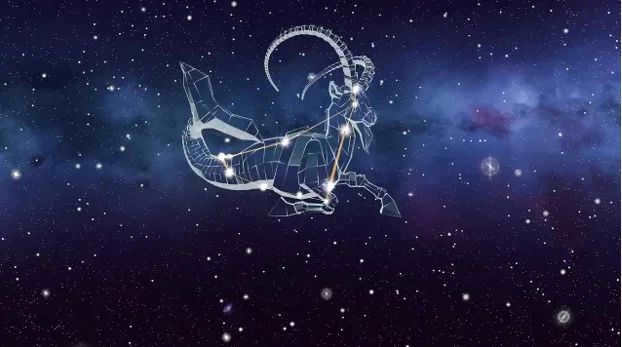
Aquarius is a zodiacal constellation that has a long history and is quite large in size. It ranks 10th in terms of its area. With the naked eye, one can observe about 90 stars in Aquarius. Some of the brightest stars in this constellation include Sadalsuud and Sadalmelik, also known as Scut. The best time to observe Aquarius is during the months of August and September. The ideal location for observing this constellation is in the center and south of the country. In Greek mythology, Aquarius is associated with several characters, including Ganymede, Deucalion, and Kekrop. Ancient civilizations considered Aquarius to be a significant constellation, representing the divine being An, who brought life-giving moisture to the earth.
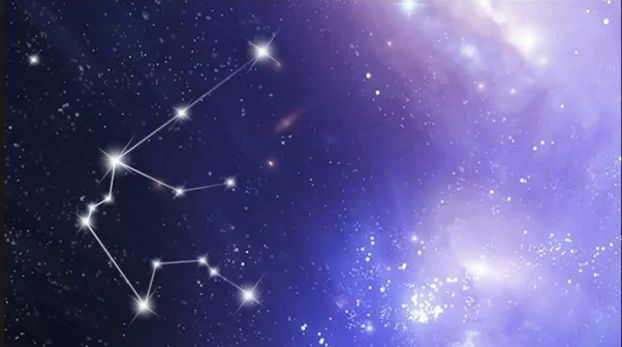
Situated in the Northern Hemisphere, this constellation ranks 14th in terms of its size. With the naked eye, it is possible to observe a total of 75 stars. The best time to observe this constellation is during the early autumn period. Known for its subtlety, this constellation falls into the category of dim constellations. It is composed of two parts: the North Fish, which consists of three stars, and the Western Fish, which consists of seven stars. These two parts are connected by an imaginary band.
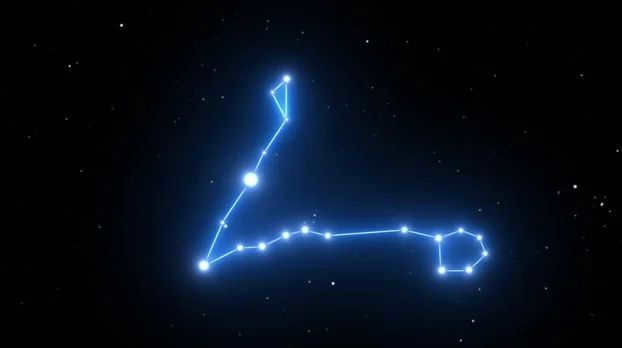
Astrologers, in contrast to astronomers, recognize only 12 zodiac signs. They create horoscopes for each of these signs, which people use daily and throughout the year. The time boundaries of astrological constellations are subjective and do not align with astronomical ones. Astrologers divided the entire circle of the ecliptic into 30-degree segments, resulting in 12 Zodiac signs that correspond to specific months of the year. The Serpent is not included in this list. According to astronomy, the Sun remains in the Scorpio constellation for 7 days, but astrology extends this period to one month.
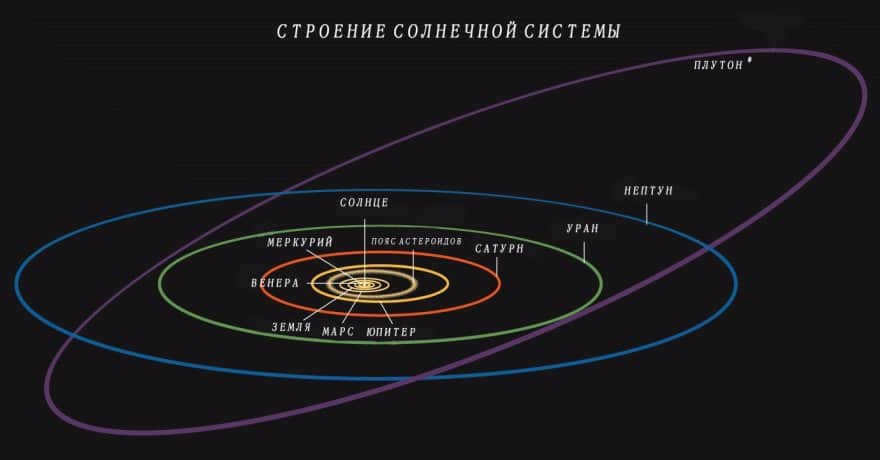
A celestial body that orbits around a star is known as a planet. The path of its movement, influenced by the gravitational force of a larger body (usually a star), is called an orbit. In our case, the Sun is the object that exerts this gravitational pull.

All of the planets in the Solar System revolve in circular orbits that align with the rotation of the star. Up until now, only one planet has been discovered that deviates from this pattern. This unique planet is called WASP-17b and it is located in the Scorpius region.
Duration of a Planetary Year
The time it takes for a planet to complete one orbit around its star is known as its sideric period. This duration can vary depending on the planet’s distance from the star; the closer the planet, the faster its orbit. As a result, the length of a year is determined by the planet’s distance from its star. If the planet is situated close to the star, its year will be relatively short.
Definition of perihelion, aphelion, and eccentricity
Perihelion and aphelion can be understood by using the planet Earth as an example.
Not all orbital paths are perfectly circular; many are elongated. The degree of elongation is known as eccentricity. A lower eccentricity value indicates a closer resemblance to a circle, while a value close to 1 indicates an ellipse. Most planets in our solar system follow orbits that are close to circular, but objects in the Kuiper belt tend to have more elliptical paths.
A skilled tarot reader can provide insights into various questions:
What does the future hold for you? How will your relationships evolve? What is the best decision to make?

Due to the absence of a perfect circular rotation, the distance between the star and the planet is in constant flux. The minimum distance is referred to as perihelion, while the maximum distance is known as aphelion.
What is the cause of seasonal changes?
Orbital inclination refers to the angle between the principal and orbital planes. The principal plane is the planetary orbital plane, also known as the ecliptic. Within our solar system, there are eight planets whose orbital paths closely align with the ecliptic plane.
Additionally, all of these planets have an inclination to the equatorial stellar plane. For instance, our planet has an inclination of 23 degrees. This inclination affects the amount of light received by both hemispheres and ultimately leads to the formation of seasons on the planet.
- Interesting facts about planets;
- Smallest planet;;
- Largest planet;

